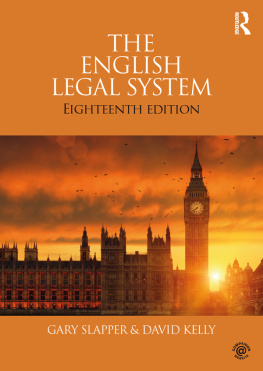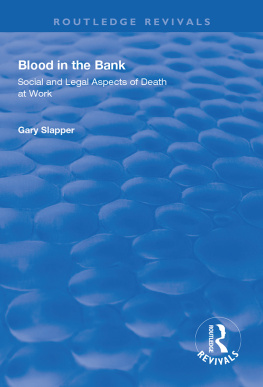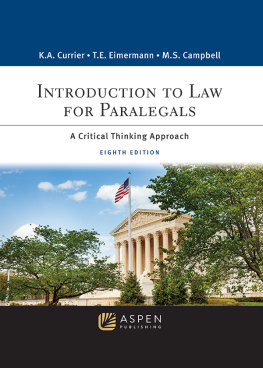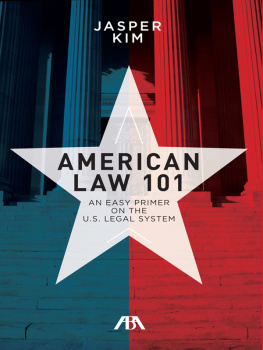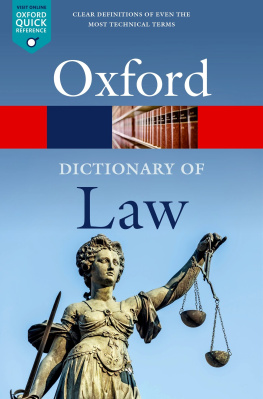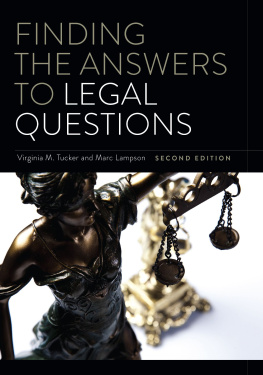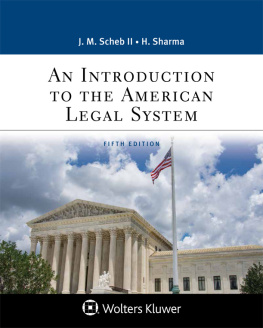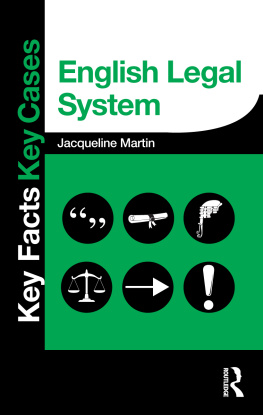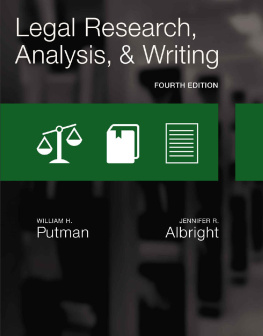Eighteenth edition published 2017
by Routledge
2 Park Square, Milton Park, Abingdon, Oxon, OX14 4RN
and by Routledge
711 Third Avenue, New York, NY 10017
Routledge is an imprint of the Taylor & Francis Group, an informa business
2017 Gary Slapper and David Kelly
The rights of Gary Slapper and David Kelly to be identified as authors of this work have been asserted by them in accordance with sections 77 and 78 of the Copyright, Designs and Patents Act 1988.
All rights reserved. No part of this book may be reprinted or reproduced or utilised in any form or by any electronic, mechanical, or other means, now known or hereafter invented, including photocopying and recording, or in any information storage or retrieval system, without permission in writing from the publishers.
Trademark notice: Product or corporate names may be trademarks or registered trademarks, and are used only for identification and explanation without intent to infringe.
First edition published by Cavendish 1994
Seventeenth edition published by Routledge 2016
British Library Cataloguing-in-Publication Data
A catalogue record for this book is available from the British Library
Library of Congress Cataloging-in-Publication Data
A catalog record has been requested for this book
ISBN: 978-1-138-28446-3 (hbk)
ISBN: 978-1-138-28447-0 (pbk)
ISBN: 978-1-315-26540-7 (ebk)
Typeset in Simoncini Garamond
by Apex CoVantage, LLC
Legal Services
We are concerned here with a number of issues related to the provision and organisation of legal services, and issues of public access to legal services. The delivery of legal services today looks very different from the way things were as recently as 1990. The legal profession has undergone a series of major changes as a result of the Courts and Legal Services Act (CLSA) 1990; the provision of public funding, advice and assistance has been drastically altered as a result of changes introduced in 1999; and the Legal Services Act 2007. The introduction of the conditional fee arrangement (no win, no fee) in 1995 was another contentious issue in this area. In the 1950s, only a minute proportion of the population used lawyers to solve problems. Now, in the twenty-first century, a great many individuals, small businesses and organisations are using lawyers often as a matter of course.
The latest Law Society statistics in Trends in the Solicitors Profession Statistical Report 2015 show that as at 31 July 2015 there were 168,226 solicitors on the Roll, that is, people qualified to work as solicitors, of whom 133,367 had a current practising certificate (PC). The number of new admissions to the Roll of solicitors declined in 2014/15 to 6,077 from a peak in the early 2000s of 8,491 in 2008/9.
The Solicitors Regulation Authority now produces monthly statistics about numbers of solicitors and law firms. The October 2016 report quotes 178,340 solicitors on the roll and 139,313 holding a practicing certificate. There were 10,415 registered law firms of which 2,627 were sole practitioners.
In 2015, there were 15,899 barristers in independent practice in England and Wales. This figure included 1,574 Queens Counsel (QCs), who are senior and distinguished barristers of at least 10 years standing (and generally with a minimum of 15 years practice) who, as a result of outstanding merit, have received a patent as one of her Majestys counsel learned in the law (Bar Standards Board website, www.barstandardsboard.org.uk).
The Legal Services Act 2007
The Legal Services Act 2007 (LSA) heralded major changes in the law. The changes prescribed in this new law are comprehensive and radical. The Act was built around Sir David Clementis proposals and the key components were:
- Creation of the Office for Legal Complaints (OLC), which in turn created the Legal Ombudsman (LO) scheme.
- Alternative Business Structures (ABSs), which enable consumers to obtain services from one business entity that brings together lawyers and non-lawyers.
- Legal Disciplinary Practices (LDPs), which allow firms to have up to 25 per cent non-lawyer or different kinds of lawyers as partners.
- A new Legal Services Board (LSB) to act as a single, independent and publicly accountable regulator with the power to enforce high standards in the legal sector, replacing a variety of regulators with overlapping powers.
- A clear set of regulatory objectives for the regulation of legal services.
The possible effects of the Legal Services Act 2007
The Legal Services Board (LSB) permitted ABSs from 6 October 2011. This enabled non-law firms to own legal practices and is commonly called Tesco Law by the media. While Tesco may well offer legal services, other large organisations have already registered an ABS. The Co-operative Society became one of the first to obtain a licence and become an ABS. Direct Line, the insurer, has since acquired a licence to become an ABS. Irwin Mitchell, a large legal practice, and Quindell, an AIM listed company, acquired ABS licences. The Solicitors Regulation Authority (SRA) has issued 340 ABS licences to date (SRA website, www.sra.org.uk, March 2015). Slater and Gordon, the Australian quoted law firm, acquired the legal practice of Russell Jones & Walker in April 2012 following the SRA granting an ABS licence. They have been acquiring more law firms. PricewaterhouseCoopers (PWC), a major international accountancy practice, has acquired an ABS for its legal practice, PwC Legal.
Professor Stephen Mayson of the Legal Services Policy Institute of the University of Law wrote in late 2013:
We are just at the second anniversary of licences being issued for alternative business structures (ABSs). In the first year, about 40 licences were issued, and progress seemed slow. A year later, there are still only two licensing authorities, but there have been roughly another 200 new licences. A year ago, we were told that there were another 200 applications in the pipeline. And we have had another 200 licences issued in the past twelve months. So it appears to have taken a year just to process the pipeline. There are no indications of how many are in the pipeline at the moment (stephenmayson.com, 6 October 2013).
The Law Society has not ignored the ABS threat to its members and, in autumn 2008, it commissioned a report by Lord Hunt, which was published on 5 October 2009 and titled The Hunt Review of the Regulation of Legal Services. This is a lengthy report, which starts by considering the recent background to the legal profession and then considers various matters including professional regulation, education and training and ABS.
In his report (p 102), Lord Hunt, in considering how ABS might work and be regulated, commented: How will the inevitable conflict between economic benefits and ethical concerns be resolved? An example of this conflict might arise where a firm decided to settle a major piece of litigation, believing that it was in the best interest of the client to do so. The practices shareholders might suffer a consequential loss of potential profit. Under company law the shareholder may be able to sue the directors for making such a decision. The Australian firm Slater and Gordon, the first legal practice in the Western world to be listed on a stock market, worked with its regulator to solve this conundrum. Its constitution states that where an inconsistency or conflict arises between the duties of the company, the companys duty to the court will prevail over all duties. This position has yet to be tested. As Stephen Mayson has pointed out in his excellent discussion paper on ABS and related issues:

